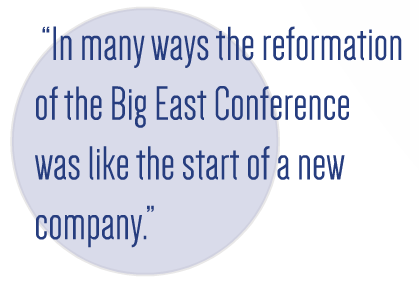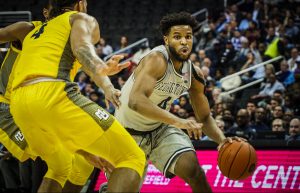 On Dec. 15, 2012, the seven Catholic, non-football affiliated member universities of the Big East Conference decided that enough was enough.
On Dec. 15, 2012, the seven Catholic, non-football affiliated member universities of the Big East Conference decided that enough was enough.
The seven schools, Georgetown among them, chose to split apart an historic basketball conference which had been in operation since 1979: the Big East. While navigating the change was initially a challenge for many involved within Georgetown’s athletic program, the university has finally found a stable conference home amid the ever-changing landscape of intercollegiate athletics.
Despite having one of the most successful basketball leagues in the country for over 30 years, the Big East’s football league lacked the financial prowess necessary to thrive in the current state of college athletics. Realizing that other conferences could provide more financial benefits, the Big East’s football schools began to seek out new homes for their respective athletic programs.
Soon, the dominoes began to fall. Syracuse University, the University of Pittsburgh, the University of Louisville, and the University of Notre Dame all departed for the Atlantic Coast Conference, West Virginia University bolted for the Big 12, and Rutgers University joined the Big Ten.
Out of fear of losing all the money associated with having a football league, especially the league’s automatic qualifying status in the lucrative Bowl Championship Series, the Big East frantically invited football schools such as the University of Memphis, Southern Methodist University, the University of Houston, and the University of Central Florida in an attempt to compensate for the mass exodus.
Feeling these new invitees did not align in terms of geography, as well as basketball and academic tradition, non-football members Georgetown, DePaul, Marquette, Providence, Seton Hall, St. John’s, and Villanova voted to dissolve the league, bringing them to that transformative moment in Dec. 2012.
“Clearly, decisions of this magnitude do not happen because of one isolated occurrence or happening,” Georgetown Director of Athletics Lee Reed wrote in an email to the Voice. “This was something that we strategically prepared for under the excellent leadership of President DeGioia and the other presidents. We were aware of the landscape and therefore prepared for the opportunities that were available to us as a conference and institution.”
Ultimately, Reed felt that the move to abandon the football schools and establish a basketball-centric league was necessary for Georgetown and the other schools involved.
“Aligning our athletics program with institutions that shared the same philosophical approach to intercollegiate athletics and education was extremely important to us,” Reed wrote. “I think we all wanted to get back to what was most important to us.”
Over the next few months, the seven schools negotiated with the remaining football schools, the University of Connecticut, the University of Cincinnati, and the University of South Florida, to retain the Big East name and the right to have its annual postseason conference tournament at Madison Square Garden, the site of the famed March basketball congregation since 1983.
“I think you have to commend everyone involved for managing such a complex separation amicably,” Reed wrote. “Ultimately, it came down to skilled negotiation and compromise but we were resolute in our desire to keep the name of the Conference and Madison Square Garden as the home for our men’s basketball tournament, both of which are inextricably linked.”
This was the first step in a months-long process that saw the seven schools build a league from scratch. They needed to hire a commissioner, find a location for a league office, and set up conference bylaws. The league eventually hired former WNBA President Val Ackerman as commissioner and set up the league’s headquarters in Midtown Manhattan.
“In many ways, the reformation of the Big East Conference was like the start of a new company with the benefit of a tremendous brand in the Big East name,” Reed wrote.
The seven schools also sought to replenish their ranks by expanding membership to ten schools. The new Big East sought out private schools located in urban areas that had strong basketball traditions and no major football program in an effort to maintain the strong level of competition that had defined the previous Big East for over 30 years. They also sought to make the league as attractive as possible to potential TV networks vying to broadcast the league’s games.
Butler University, located in Indianapolis, Creighton University in Omaha, Neb., and Xavier University located in Cincinnati, Ohio all accepted invites to join the league based off their strong credentials. As a result of these additions, the league now had seven schools located in the nation’s top 35 television markets, a crucial metric in an age of intercollegiate athletics when so many decisions are made with the ramifications of nationwide television marketability in mind.
All 10 schools convened for a press conference in New York on March 20, 2013 to formally announce the league’s new structure as well as a new 12-year broadcasting deal with Fox Sports and its brand new cable network, Fox Sports 1, worth roughly $600 million.
Reed declined to comment on how much money Georgetown receives annually from its television contract with Fox, but explained the significance of the network’s relationship to the schools within the Big East.
“Our partnership with Fox Sports is about more than the money,” Reed wrote. “Ultimately, it is an integrated relationship that focuses on providing each partner with the best platform possible to enhance our respective brands and organizations.”
In its first two years of existence, the new Big East so far has maintained the high level of basketball competitiveness that quickly made it one of the toughest and most distinguished leagues in the country. The inaugural 2013-14 season saw the conference ranked as the fourth-toughest conference in the country, according to the NCAA Ratings Percentage Index, a measurement used to rank teams based upon wins, losses, and strength of schedule. The league has become even more difficult in its second year.
This season, at the time of this article’s publication, the league is ranked as the second toughest in all of college basketball according to RPI, behind only the Big 12, and has seen six teams (Georgetown, Butler, Creighton, Providence, Seton Hall, St. John’s and Villanova) all spend at least one week ranked in the one of the national Top 25 polls. Both years, the new Big East ranked tougher than the ACC, the league many of which the Big East’s former members departed.
 Although the league has remained competitive on the court, it has not maintained the same visibility off the court. While the Hoyas’ new relationship with Fox has resulted in the more nationally televised games than ever before, not as many people are watching the Hoyas’ games. During the 2013-14 season, the Hoyas had 25 of their games nationally televised, as opposed to 16 in the 2012-13 season. Those 25 games averaged 222,654 viewers per game while the 16 games in 2012-13 averaged 818,588 viewers per game. The Voice was unable to obtain complete television ratings figures for Georgetown’s broadcasted games this season, but the limited sample obtained did not show much deviation from last year’s downturn.
Although the league has remained competitive on the court, it has not maintained the same visibility off the court. While the Hoyas’ new relationship with Fox has resulted in the more nationally televised games than ever before, not as many people are watching the Hoyas’ games. During the 2013-14 season, the Hoyas had 25 of their games nationally televised, as opposed to 16 in the 2012-13 season. Those 25 games averaged 222,654 viewers per game while the 16 games in 2012-13 averaged 818,588 viewers per game. The Voice was unable to obtain complete television ratings figures for Georgetown’s broadcasted games this season, but the limited sample obtained did not show much deviation from last year’s downturn.
Reed is content with the Hoya’s relationship with Fox, despite the lower viewership compared to the previous contract with ESPN.
“We are only in year two of a multi-year partnership and we are happy with our progress to date and excited about the future possibilities,” he wrote. Georgetown Men’s Basketball Head Coach John Thompson III could not be reached for comment.
In order to maintain and enhance the team’s popularity, men’s basketball team has taken steps to revive the old rivalries left behind after the realignment, especially their storied rivalry with Syracuse. Last year was the first time the longtime rivals had not played each other since the 1977-78 season. But, unlike some schools, who due to the realignment process have opted to shun scheduling their historic rivals, such as Kansas-Missouri, and Texas-Texas A&M, both Georgetown and Syracuse announced a four-year agreement to play each other once annually, beginning next season at Verizon Center. Georgetown also recently announced an agreement for a two-year home-and-home series with former Big East rival Connecticut that will begin next season as well.
Reed wrote to the Voice that losing Syracuse as a league member “was one that we knew our fans would struggle with because of how meaningful the rivalry had become over the decades.” As a result, he made renewing these rivalries through non-conference scheduling a priority because he knew it would be “terrific for our fans and college basketball.”
But while most in the Georgetown community have focused on the effects of conference realignment with regards to the Hoyas’ prestigious men’s basketball program, the move from the old conference setup to the new one also affected 25 of Georgetown’s 29 Division-1 teams. Aside from women’s rowing, which joined the Patriot League due to the new conference not sponsoring the sport, all of the aforementioned sports made the transition from the old Big East to the new Big East. Only football, men’s rowing, and the sailing teams, both coed and women’s, did not see their conference affiliation shift, since they were never a part of the old Big East.
The initial effects of realignment were particularly scary to those in the non-revenue sports. Georgetown Men’s Soccer Head Coach Brian Wiese said he felt powerless during the beginning stages of the fever that caused the landscape of the Big East to shift.
“You always had the feel that you were in the ocean getting tumbled around by giant waves, because you had no control over where you were going,” Wiese said. “Until the point where we broke off and became a basketball-centered conference, we were hugely at the mercy of all these decisions that had nothing to do with anything that the schools in the Big East now were interested in.”
To some athletes, such as Georgetown men’s lacrosse senior midfielder Joe Bucci, the realignment fever has gotten out of hand.
“I think it’s a little ridiculous,” Bucci said. “It sort of takes away what conferences were meant to be, which were local established teams playing each other, trying to gain a stronghold and get into the NCAA Tournament. In the traditional sense, I don’t think it’s right. But at the same time, it allows for new things to happen.”
Other coaches, such as Georgetown Men’s and Women’s Tennis Head Coach Gordie Ernst, however, did not care about realignment, saying it does not affect the way his teams play and practice.
“I paid about as close attention to that as I pay attention to the birdwatching report, or the updates on what celebrities like the Kardashians are doing,” Ernst said.
Men’s soccer has greatly benefited under the new structure, according to Wiese. In the old league the behemoth, 16-team conference was split into two eight-team divisions, Blue and Red. Every team would play the schools within their division at least once, aside from one intradivisional home-and-home, along with one cross-over game with the other division. As a result, the Hoyas, who were part of the Blue Division, would not play nearly half of the league’s teams in a given season. When realignment condensed the league to 10 teams, every team got to play each other once, not only bringing new matchups, but also potentially creating new rivalries.

“[Realignment] gives us a chance to establish new rivalries and play new teams that we would have never played against before and travel to places that we’ve never been,” senior forward/midfielder Austin Martz said. “Because it’s not just about the game, it’s about the experience, too.”
Despite being six teams lighter and losing nationally renowned programs such as Connecticut and Notre Dame, the conference is as competitive as ever. This past season saw four teams from the conference (Georgetown, Creighton, Providence, Xavier) ranked in the Top 15 of the national RPI. Two of those teams (Georgetown & Creighton) made it to the Quarterfinals of the NCAA Tournament, while Providence did even better, making it all the way to the College Cup Semifinals.
The increased reputation of the conference’s soccer programs has also helped Wiese and his fellow assistants recruit prospective high school talent.
“We get kids who say ‘Hey, I want to play in the Big East.’ And that’s good,” Wiese said. “I think the Big East has a great name, and in our recruiting efforts kids are really excited about the potential of playing against Creighton and Marquette and St. John’s. These are games they’re excited about.”
Although for most sports the Big East name has helped attract recruits to the Hilltop, the Georgetown name ultimately goes the longest way.
“We are Georgetown. That is the most powerful recruiting tool and our school gets us in the door with most recruits,” Georgetown Softball Head Coach Pat Conlan wrote in an e-mail to the Voice.
While sports such as soccer simply saw their league shrink from a huge conference to a simple one, sports such as men’s lacrosse had more work to do after the initial announcement of the new conference in March 2013.
With the departures of Syracuse, Notre Dame, and Rutgers, the conference was left with only five members that sponsored men’s lacrosse (Georgetown, Marquette, Providence, St. John’s, Villanova), meaning that the conference had to add an associate member in order to meet the minimum requirement of teams necessary to hold a postseason conference tournament, the winner of which receives an automatic bid to the NCAA Tournament.
Georgetown Men’s Lacrosse Head Coach Kevin Warne and his fellow Big East coaches sought a team that would help elevate the league’s national profile as well as maintain the high competition level of the league. And they feel they have found all that with the addition of the University of Denver, who joined the Big East as an associate member in lacrosse last season to round out the league.
Although an unorthodox fit geographically, considering they are located 1,049 miles away from the next closest league member, Marquette, and are two time zones away from Georgetown and the rest of the league’s Northeast-based members, the Pioneers have met all the expectations Warne and the other Big East coaches had for them. They reached the Final Four last season and are currently ranked No. 4 in both national polls.
“I think our Big East lacrosse coaches, as a whole, did a really good job,” Warne said. “We got on a bunch of conference calls and decided to say ‘Hey, we need to get a team in here that fits that criteria’. I think we did a really good job of investigating what was best for our conference.”
Whereas sports such as soccer and lacrosse have been greatly affected by realignment, for some sports, such as the Georgetown track and cross country teams, realignment has had a minimal effect on how the program operates.
“The realignment of the Big East has not been a big detriment to our program,” Georgetown Director of Men’s and Women’s Track & Field and Cross Country programs Patrick Henner said. “If anything, right now, I feel like our men’s and women’s programs are on the rise and are better than they’ve been since I’ve been here.”
Although other team sports such as basketball, lacrosse, and soccer rely on postseason conference tournaments to determine automatic qualifiers into the NCAA Tournament, cross country and track & field do not share the same qualifying method. The Big East Championships are more about pride than anything else, but due to realignment the meets are not as competitive as they used to be.
“When we had 16 teams, every single event you had to be an NCAA-caliber athlete to do well in that event,” Henner said. “Now some of the events, because we only have seven or eight schools, some of the events are watered down. There are some events where you can score substantial points and not be an NCAA-caliber athlete.”
Overall, however, Reed believes that the new Big East has been a positive development for Georgetown athletics.
“While it is relatively early in the transition, I believe that the bold decision for us to create the new Big East was absolutely the best outcome for Georgetown University,” Reed wrote.
Georgetown has come a long way since that fateful announcement and subsequent negotiations to resurrect the Big East as a conference where basketball s king. There are some at Georgetown who like to imagine that the negotiations did not amount to numerous conference calls and board meetings but, rather a simple game of basketball, and the conference has not looked back since.
“Here’s how I think the whole thing went: the presidents of these universities all got together and probably were shooting hoops,” Wiese joked. “They were probably playing pickup basketball and they had seven and they were like ‘we need three.’ Let’s do this.”





